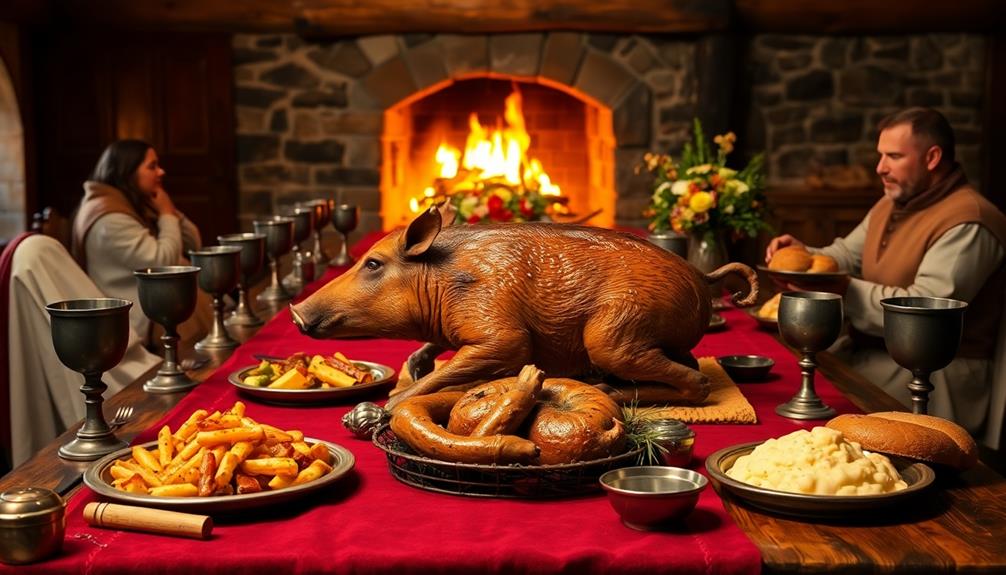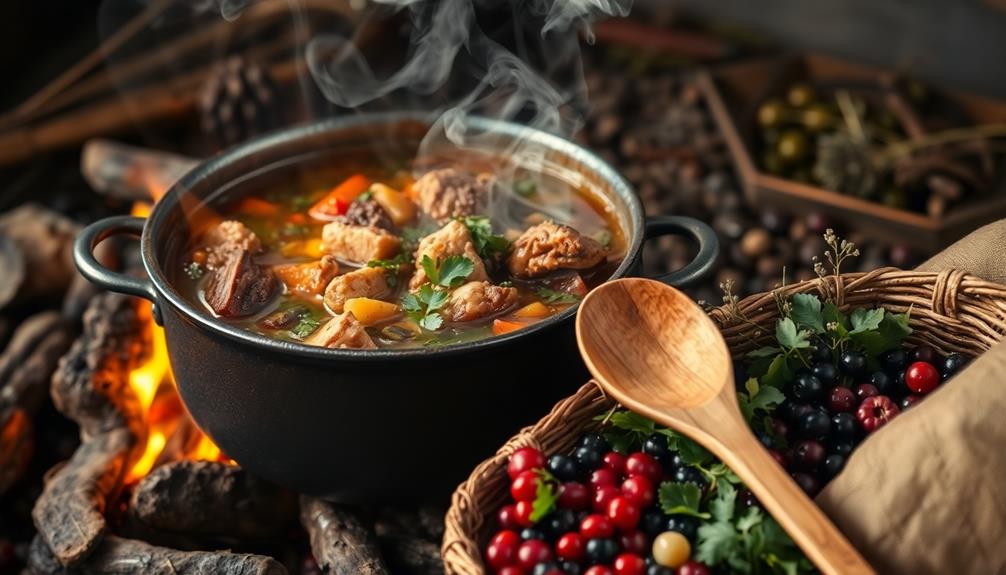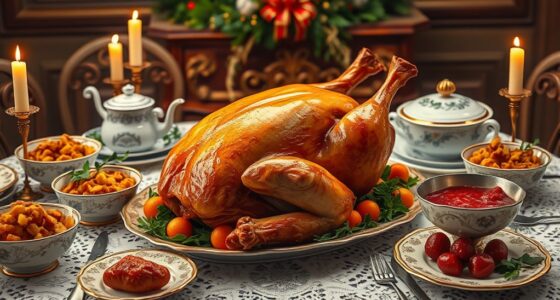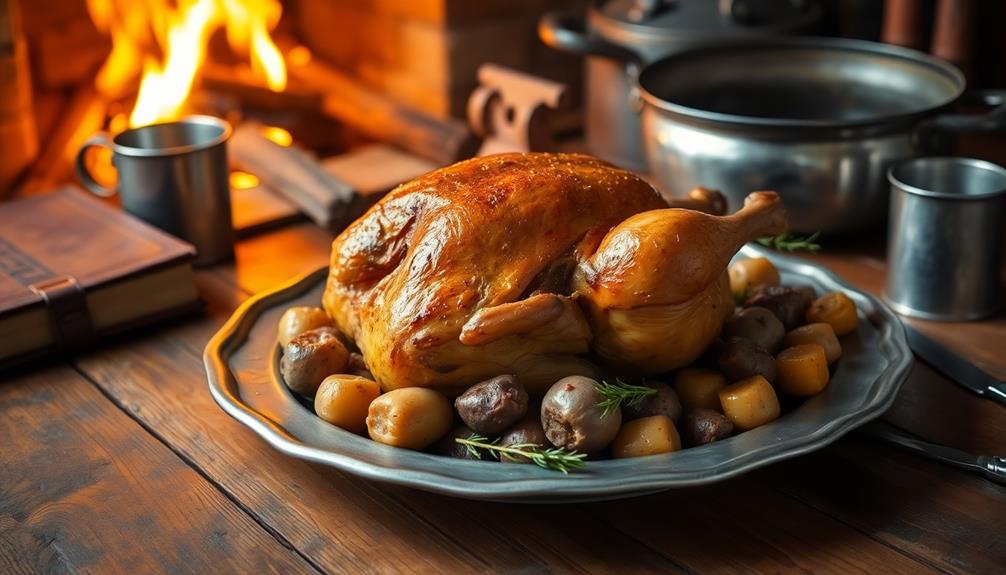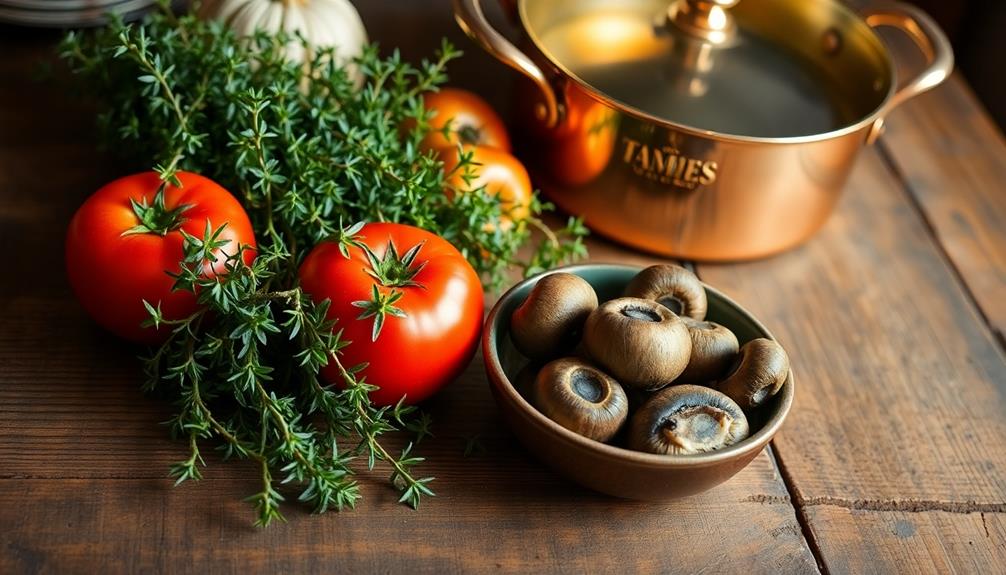Step back in time and join the noble knights at their grand medieval banquet! The air is thick with the savory scents of roasted boar, seasoned with aromatic herbs and spices. The table shines with gleaming pewter mugs, reflecting the candlelight's warm glow. As you take your seat, the lively chatter and clinking of cups envelop you, transporting you to a world of feasting and merriment. Though the feast may be fit for a king, you'll soon discover there's much more to uncover about the traditions and customs that made these medieval gatherings truly extraordinary.
Key Takeaways
- Lavish medieval banquets showcased the wealth and power of the nobility, featuring savory meats, sweet vegetables, and a focus on community and celebration.
- Attendees experienced a warm, festive atmosphere with flickering candlelight, clinking pewter mugs, and lively music and entertainment.
- Preparing a medieval feast involved collecting sturdy cookware, fresh ingredients, and using aromatic herbs to enhance the flavors of roasted meats.
- Roasted boar, symbolizing power and prestige, was a featured dish, typically seasoned and slow-roasted for 3-4 hours.
- Modern reenactments of medieval banquets allow people to experience historical dining customs and engage with the rich cultural heritage.
History
In the Middle Ages, medieval banquets were grand affairs that showcased the wealth and power of nobility. Imagine yourself as a knight, sitting at a long, ornate table, surrounded by the clinking of silverware and the chatter of guests. The air would be thick with the mouthwatering scents of roasted meats, freshly baked bread, and rich, creamy sauces.
As the feast began, servers would parade in, carrying platters piled high with succulent fowl, tender venison, and fragrant vegetables. You'd eagerly await your turn to select the choicest morsels, savoring each bite as the flavors danced on your tongue.
Between courses, minstrels would entertain the crowd with lively music and poetry, while jesters performed amusing antics to delight the diners.
Throughout the evening, the lord and lady of the manor would hold court, conversing with their guests and overseeing the festivities. It was a time of indulgence, camaraderie, and the celebration of the privileges of the noble class.
Medieval banquets were truly a feast for the senses!
Recipe
Roasted Boar with Spiced Apples
Medieval feasts were a grand display of extravagance and indulgence. At the center of these lavish celebrations was the roasted boar, a symbol of power and prestige. This succulent dish, often accompanied by a variety of seasonal produce, exemplified the culinary artistry of the era.
The preparation of the roasted boar required both skill and patience. The meat was carefully seasoned with a blend of herbs and spices, then slowly roasted over an open fire until it achieved a rich, caramelized crust. The resulting feast was a true testament to the epicurean delights of the Middle Ages.
Ingredients:
- 1 whole boar, approximately 8-10 lbs
- 2 tbsp salt
- 1 tbsp black pepper
- 1 tsp ground cinnamon
- 1 tsp ground cloves
- 1 tsp ground nutmeg
- 4 large apples, peeled, cored, and sliced
- 2 cups apple cider
- 1 cup honey
Cooking Instructions:
Preheat your oven to 325°F (165°C). Rub the boar all over with the salt, black pepper, cinnamon, cloves, and nutmeg.
Place the boar on a roasting rack in a large roasting pan. Pour the apple cider and honey over the top of the boar. Arrange the sliced apples around the base of the pan.
Roast the boar for 3-4 hours, basting every 30 minutes, until the internal temperature reaches 145°F (63°C) for medium-rare or 160°F (71°C) for well-done.
Tips:
When selecting a boar, choose one that's young and tender. The older the boar, the tougher the meat.
Additionally, basting the roast frequently will help ensure a moist and flavorful result. Serve the roasted boar with the spiced apples and the pan juices, and accompany it with a selection of seasonal vegetables and freshly baked bread for a truly authentic medieval feast.
Cooking Steps
Gather up some firewood and kindling to get that fire roaring.
Then, prepare your ingredients and cooking utensils.
Next, you'll want to marinate the meat in a nice wine mixture before roasting it to perfection.
Serve it all up with some delicious seasonal veggies for a truly mouthwatering medieval feast!
Step 1. Gather Firewood and Kindling
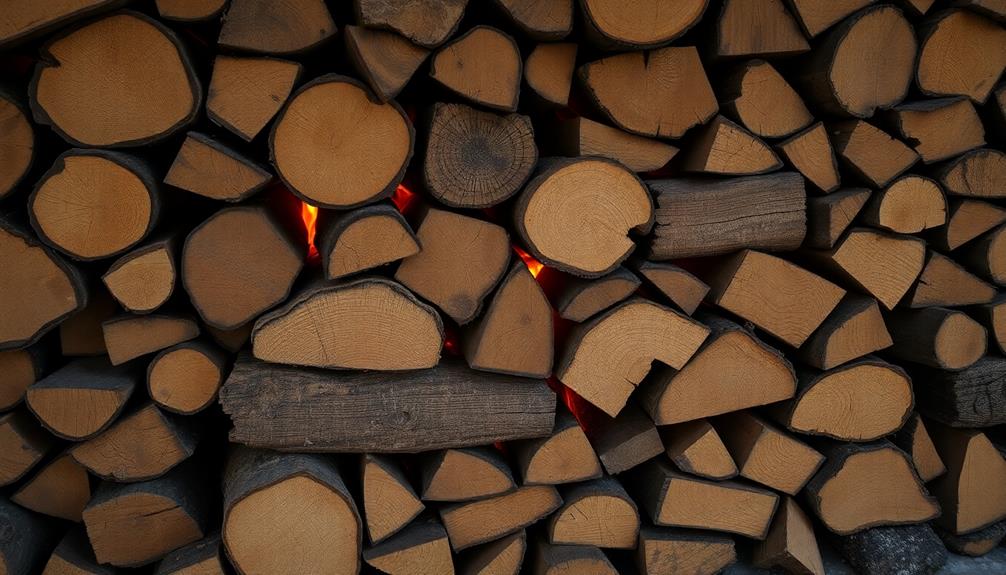
Gathering the necessary firewood and kindling is a crucial step in preparing for the medieval banquet.
You'll want to collect an ample supply of dry, seasoned wood to ensure a strong, steady flame that will last throughout the evening's feast.
Begin by venturing into the nearby forest, your trusty axe in hand, and search for fallen branches or small logs. Carefully select pieces that are free of moisture, as damp wood won't burn as brightly.
Once you've gathered a sizable stack, find some tightly-rolled pieces of parchment or newspaper to use as kindling. These will help ignite the firewood quickly and efficiently.
Arrange the kindling and wood in the fireplace or outdoor fire pit, leaving spaces for the air to circulate.
With a single spark, the flames will spring to life, radiating warmth and setting the stage for a delightful medieval banquet.
Step 2. Prepare Ingredients and Utensils
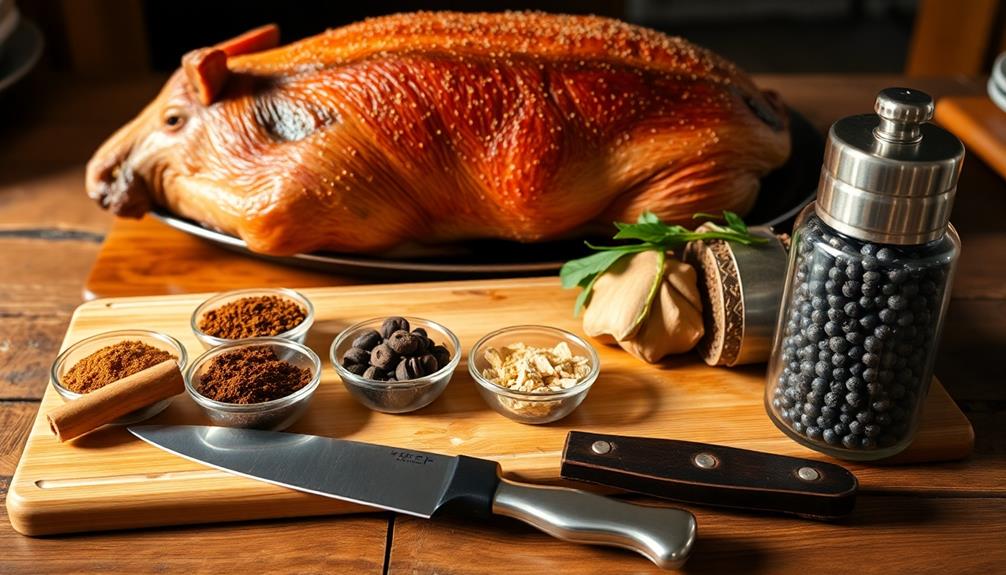
With the fire now crackling, you'll need to prepare the necessary ingredients and utensils for the medieval feast.
First, gather your cooking pots, pans, and any other vessels you'll need. These sturdy, iron-forged tools will help you prepare the sumptuous dishes fit for a knight.
Next, round up your fresh produce – crisp vegetables, fragrant herbs, and juicy fruits. Don't forget the meats, whether it's succulent venison, savory poultry, or flavorful fish.
You'll also need salt, pepper, and any other seasonings to bring out the bold, medieval flavors. Set these ingredients within easy reach, so you can quickly add them to your simmering pots and pans.
Finally, make sure you have plenty of wooden platters, trenchers, and cups ready to serve your delectable creations.
With your workspace prepared, you can start transforming these raw materials into a feast fit for a king!
Step 3. Marinate Meat in Wine Mixture
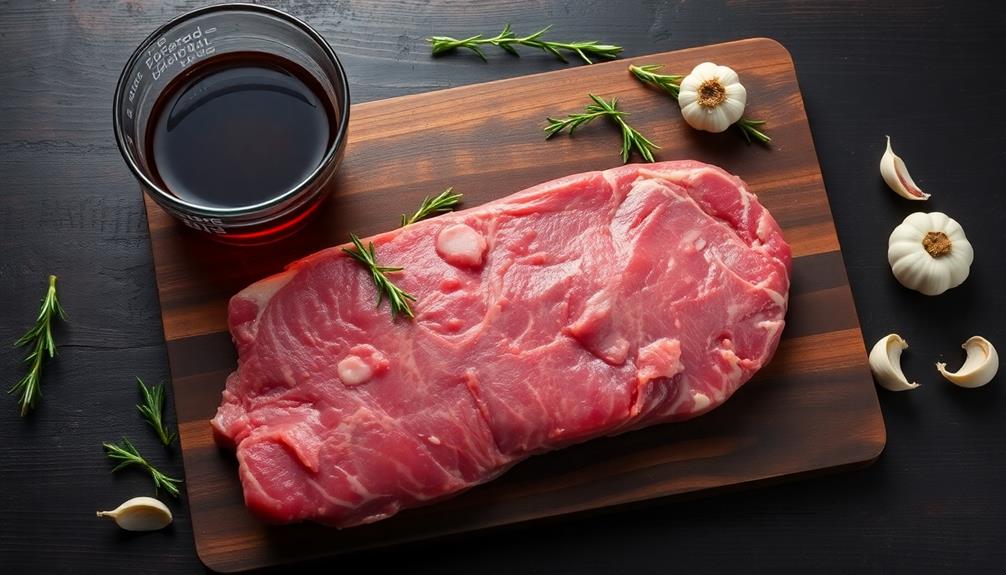
Marinating the meat in a rich wine mixture is a crucial step to infusing your medieval dishes with bold, complex flavors. Start by combining a full-bodied red wine, fragrant herbs, and aromatic spices in a large bowl.
Carefully add the tender cuts of meat, ensuring they're fully submerged in the fragrant marinade. Cover the bowl and let the meat soak up all that delicious flavor for at least a few hours, or even overnight if you have the time.
As the meat marinates, the wine will tenderize the fibers, while the herbs and spices will work their magic, transforming the ordinary into the extraordinary.
Imagine the mouthwatering aroma wafting through the castle as the meat soaks up all those rich, savory notes. When you're ready to cook, simply remove the meat from the marinade and sear it to perfection.
Get ready for a flavor explosion that will transport you back to the grand feasts of the Middle Ages!
Step 4. Roast the Marinated Meats
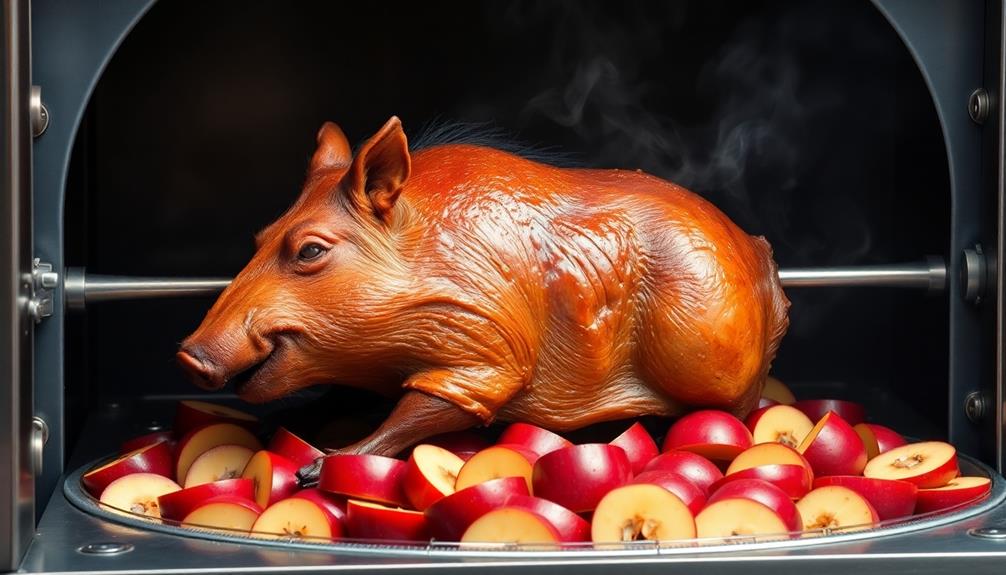
Once the meat has soaked up all those wonderful flavors from the marinade, it's time to move on to the next step – roasting.
Grab your largest roasting pan and preheat your oven to a toasty 375°F. Carefully place the marinated meats into the pan, making sure they're not crowded together. You want plenty of room for the juices to sizzle and the meat to brown evenly.
As the oven heats up, you'll start to smell the mouthwatering aroma of the meat roasting. It'll make your stomach rumble with anticipation!
Keep a close eye on the meat, turning it every 15 minutes or so, until it's cooked to a perfect golden-brown. Use a meat thermometer to make sure it reaches the ideal internal temperature – around 145°F for medium-rare.
Once it's ready, take the pan out of the oven and let the meat rest for a few minutes before slicing into it. This allows the juices to redistribute, making every bite juicy and flavorful.
Step 5. Serve With Seasonal Vegetables

To complement the mouthwatering roasted meats, you'll want to whip up some delectable seasonal vegetables. Imagine the vibrant colors of fresh carrots, parsnips, and Brussels sprouts, all sizzling in a pan with a drizzle of fragrant olive oil. The sweet, earthy aromas will fill the air, making your mouth water in anticipation.
Now, gently toss the vegetables to ensure they're evenly coated and let them roast to perfection. You'll know they're ready when they've developed a delightful caramelized crust, yet remain tender and juicy on the inside.
For an extra burst of flavor, you can sprinkle in some aromatic herbs like rosemary or thyme.
Serve the roasted vegetables alongside the succulent roasted meats, creating a visually stunning and harmonious feast fit for a king. The combination of the savory meats and the sweet, tender vegetables will delight your senses and leave your guests thoroughly satisfied.
Final Thoughts
As we reflect upon the medieval banquet, let's consider the enduring legacy it has left behind. The sights, sounds, and flavors of those grand feasts have captured the imagination of people for centuries.
Imagine the flickering candlelight, the clinking of pewter mugs, and the lively chatter as knights and nobles indulged in hearty dishes.
Though the formality and extravagance may seem a world away, the spirit of community and celebration lives on.
Modern-day reenactments and themed events allow us to step back in time and experience the joy of dining like a true medieval lord or lady.
Who knows, you might even learn a thing or two about the etiquette and customs that were essential back then.
Frequently Asked Questions
What Type of Entertainment Was Provided at Medieval Banquets?
At medieval banquets, you'd be entertained by minstrels, musicians, and jesters who'd perform songs, dances, and comedic acts to liven up the festivities and keep the guests engaged throughout the evening.
How Did the Seating Arrangements Reflect the Social Hierarchy?
At a medieval banquet, seating arrangements reflected the social hierarchy. You'd find the most honored guests seated closest to the host, while servants and commoners were seated further away, with their position determined by their rank and status.
What Types of Tableware Were Used During Medieval Banquets?
During medieval banquets, the tableware reflected the diners' social status. The noble guests used ornate silver or gold plates, cups, and utensils, while commoners used simpler wooden or pewter dishware.
Were There Any Specific Table Manners Expected at These Events?
At medieval banquets, you'd be expected to follow strict table manners. Hands off the tablecloth, no double-dipping, and keep your elbows off the table. Proper etiquette ensured a refined dining experience for all.
How Were the Guests Expected to Dress for a Medieval Banquet?
You were expected to dress in your finest attire for a medieval banquet. Elaborate gowns, tunics, and cloaks adorned with embroidery or fur were common. Proper etiquette dictated that you present yourself as a noble guest.
